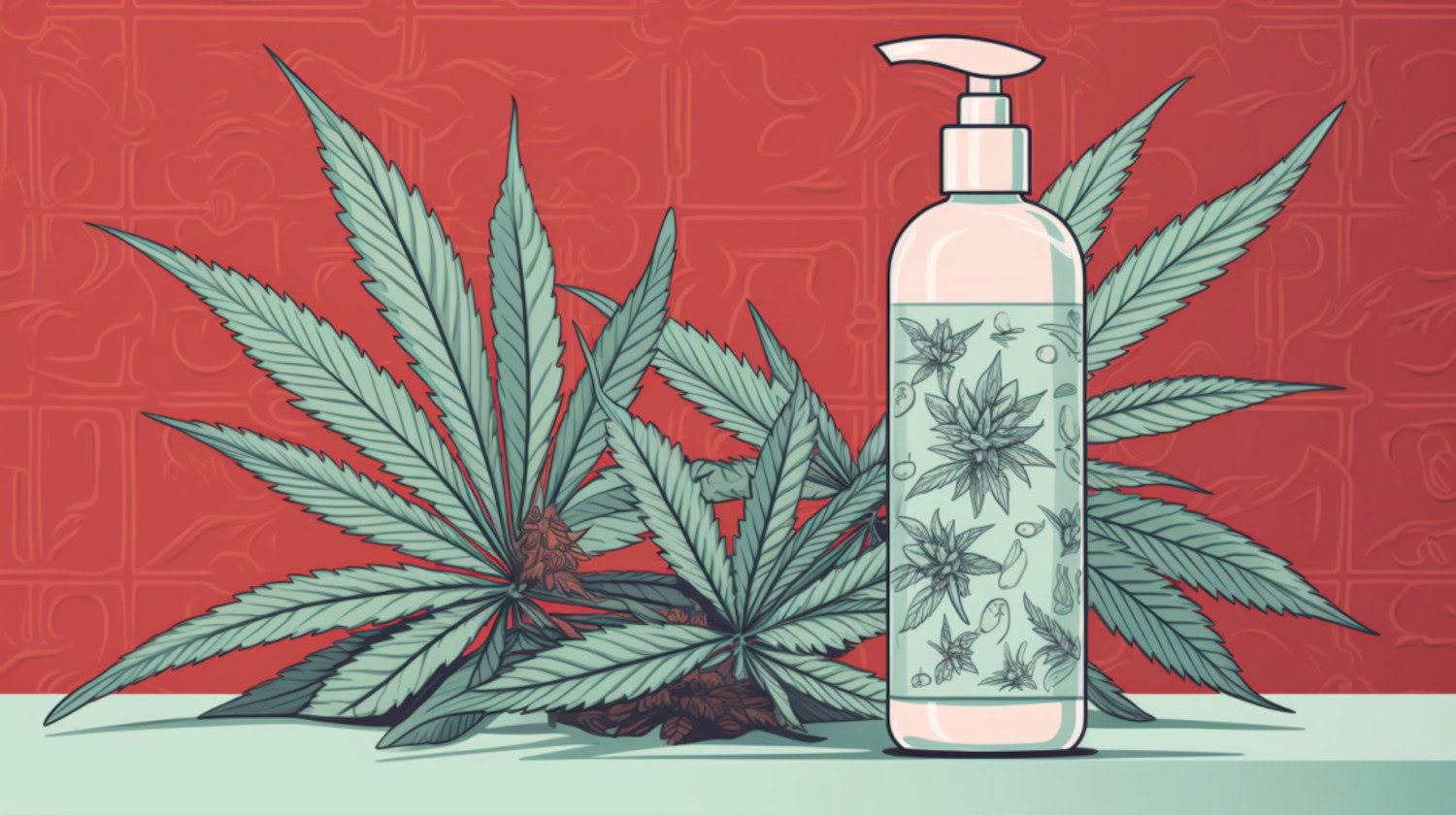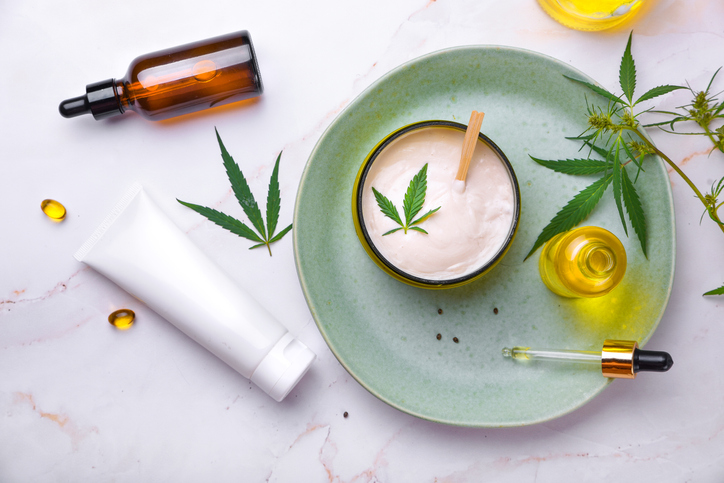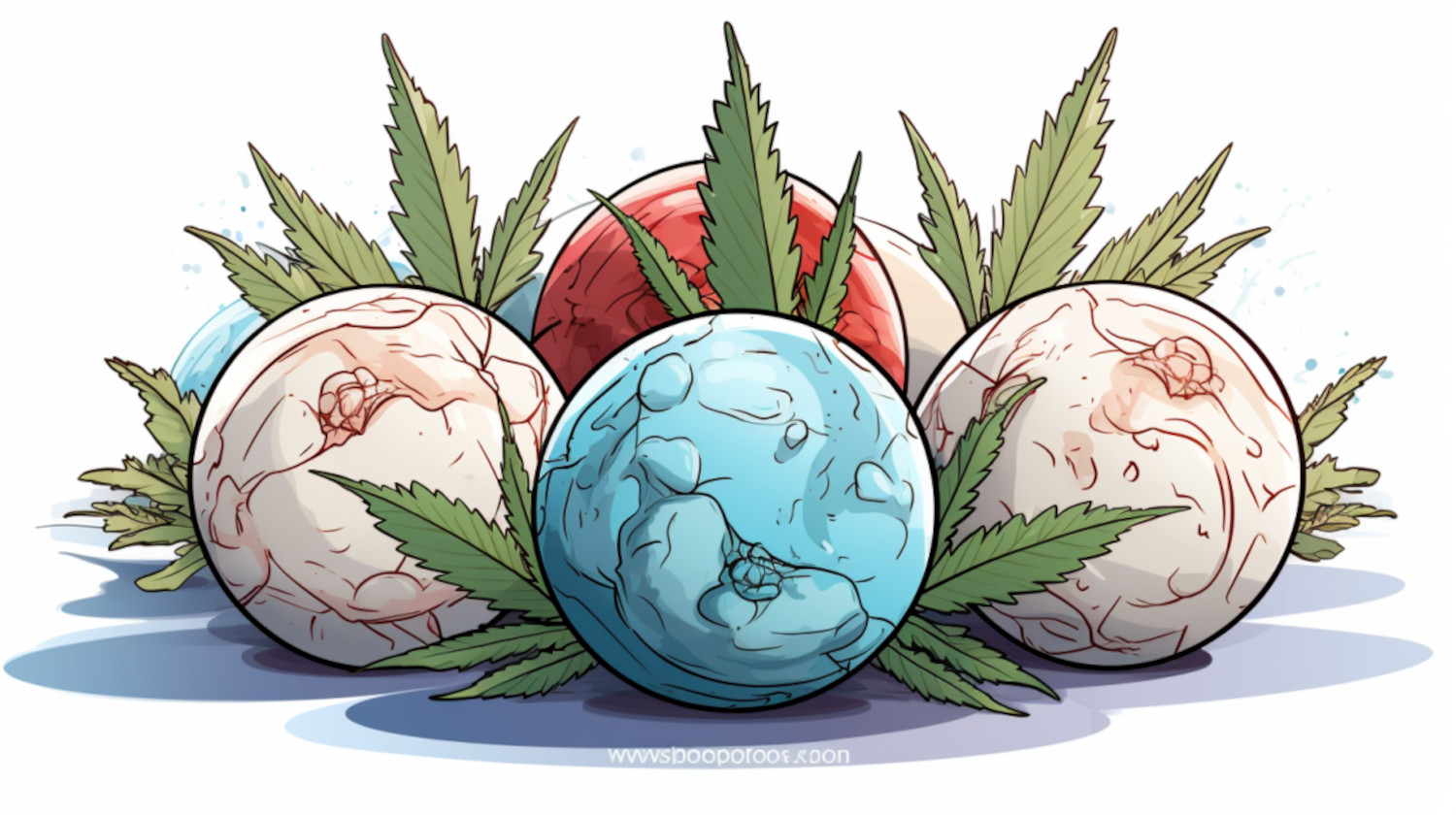In This Article
- How Do CBD Creams Work?
- How Do Drug Tests Work?
- Can Topical CBD Show in a Drug Test?
- Does CBD Lotion Show Up on a Drug Test?
- Will Hemp Oil Show Up on a Drug Test?
- Can Hemp Lotion Show Up on a Drug Test?
- Can Products with 0.3% THC Show Up on a Drug Test?
- If You Pass a Home Drug Test Will You Pass a Lab Test?
- References
CBD creams are everywhere, from medicine cabinets to makeup bags. Topical cannabis may be newly popular, but it’s been used as medicine for thousands of years for pain and inflammation. However, given the complications around cannabis, new users often wonder: Does CBD cream show in a drug test?
Today, CBD (cannabidiol) creams are the go-to for conditions ranging from arthritis to eczema. With many reported benefits, including anti-inflammatory, antimicrobial, antioxidant skin protection, anti-itch, and pain relief, even people who might resist cannabis are considering using CBD. When applied to the skin, they may offer relief without intoxication.
However, many businesses and industries require drug testing for pre- and ongoing employment, compliance, or safety protocols. If you use CBD cream and take a drug test, will you test positive? The answer is tricky, but knowing how drug tests work and what labs test for can provide peace of mind.
How Do CBD Creams Work?
Our skin provides a straightforward way to deliver CBD topically and transdermally or through deeper layers of the skin into the bloodstream.
Different chemical enhancers make CBD products work more effectively to permeate the skin and improve absorption. For instance, particles called organosilanes move these substances through the skin and into the body. Other substances, such as oleic acid and ethanol, can also enhance the absorption of cannabinoids.
When applying creams to the skin, they reach different layers. Most products reach the top layer, the epidermis, or deeper layers, like the dermis and hypodermis. CBD creams can also affect hair follicles, sweat glands, and nails. Transdermal products, on the other hand, deliver drugs through the skin, allowing the medication to get into the bloodstream and affect the whole body.1
When applied to the skin, topical CBD cream interacts with the body’s natural endocannabinoids. CBD inhibits a specific enzyme, FAAH, increasing the levels of helpful endocannabinoids. Here, CBD works on both cannabinoid and non-cannabinoid receptors. This interaction can reduce itching and inflammation. Other cannabinoids, like THC and PEA, reduce itching and inflammation in animal studies, but the results vary in humans.
CBD benefits overall skin health and repairs skin from injury. A study on mice showed that increased levels of an enzyme called HMOX1 and the protein keratins 16 and 17 caused skin repair and wound healing.
In vitro studies on human skin cells show CBD can penetrate skin cells, protecting them against oxidative stress caused by environmental factors like UV rays and pollution. It also protects and helps store essential fatty acids in cell membranes, keeping cells healthy. CBD may activate PPAR-y receptors that manage inflammation and metabolic processes within cells.2
CBD also affects skin conditions by acting on other receptors. Its action on the CB2 receptors (found in immune cells and tissues) reduces the response to inflammation. The reactions on the TRPV1 receptors (found in skin cells, nerves, blood vessels, and hair follicles) control pain and itch sensations. CBD can help manage pain and itchiness while reducing skin inflammation.3
Since CBD is beneficial in maintaining skin health and preventing inflammation and itching at a cellular level, does it help with skin conditions?
For acne treatment, hemp essential oil contains terpenes like myrcene, α-pinene, and β-caryophyllene, which may work against the bacteria that cause acne. These work like CBD, targeting acne formation by reducing excess oil, preventing pore blockage by skin cells, alleviating inflammation, and combating bacterial growth.
Other inflammatory skin conditions, like eczema and atopic dermatitis, may benefit from CBD treatment. CBD regulates HMOX1 and PPAR-y, protecting cells from inflammation, oxidation, and programmed cell death.
CBD and hemp products are promising in skin care, especially for inflammation, itching, pain, and bacterial infections. While more research is underway to understand how effective CBD is in human skincare, its actions at a cellular level highlight its potential for various skin conditions.
How Do Drug Tests Work?
Drug tests are often used in employment, law enforcement, and healthcare fields. They detect the presence or absence of specific drugs or their metabolites, which the body creates byproducts as it breaks down the drug.
Test analysis commonly includes cannabis products in screening panels. Brian Kessler, MD, Chief Medical Officer for NuggMD, clarifies, “Drug tests detect metabolites; for THC, this is 11-COOH-THC, and for CBD, this is 7-COOH-CBD.”4 Most drug testing focuses on illicit substances, and a CBD screen isn’t typical.
Common tested-for substances are amphetamines, cannabinoids, cocaine, opiates, and phencyclidine (PCP). These are the “NIDA five,” designated by the National Institute on Drug Abuse (NIDA) for recommended screening.
The primary technology used in drug testing is immunoassays, a lab test that measures metabolites' presence or concentration in a sample. Drug testing can use blood, hair, saliva, and breathalyzer results. Still, urine is the most common biological sample used for immunoassay testing due to its high sensitivity and ease of testing.
The U.S. Department of Health and Human Services (HHS) indicates that a concentration of THC metabolite 11-COOH-THC above 15 ng/mL in urine constitutes a positive urine test. Urine THC metabolite tests don’t identify synthetic cannabinoids or CBD and do not determine impairment.5
Can Topical CBD Show in a Drug Test?

Topical CBD creams applied to the skin absorb into the top layers. They work locally at the application site and don’t enter the bloodstream. Even with the use of a topical cream with THC, the skin barrier prevents systemic effects. Dr. Kessler agrees, “We don’t have any evidence to suggest that chronic use of CBD topicals will show up on a drug test.”
Most drug tests don’t test for the CBD metabolite. If taken orally, CBD screening can detect its presence for up to a month for daily users, but the topical application won’t register. Topical THC is also unlikely to appear in blood or urine tests.6
However, transdermal patches and topical products with penetration-enhancing ingredients work differently. Engineered transdermal products deliver substances through the skin and into the bloodstream. According to research, transdermal products can introduce cannabinoids, including THC, into the circulatory system. Transdermal products use advanced formulations like nano-systems, which utilize ultra-small particles for deeper skin penetration. These tiny particles are encapsulated in micellar or liposomal spheres or micro-emulsified to deliver active ingredients through the skin.7
Therefore, while standard creams and lotions are unlikely to lead to positive drug tests, transdermal patches with enhanced absorption properties might carry a higher risk.
As for bath bombs and bath salts, no research or report indicates positive drug test results.
Does CBD Lotion Show Up on a Drug Test?
CBD lotion applied to the skin's surface doesn’t penetrate deeply enough to reach the bloodstream. As Dr. Kessler points out, “Unless CBD lotion is made with ingredients made for enhancing penetration and has been contaminated with THC, it is not likely to cause a positive drug test.”
Only transdermal products with THC could potentially register on a drug test. Most CBD lotions are not made with skin-penetration-enhancing ingredients and are made from CBD isolate.
Will Hemp Oil Show Up on a Drug Test?

Hemp products, particularly hemp oil and hemp seed, are popping up in nutrition and health stores. Both come from the hemp plant, a variety of the Cannabis sativa plant. Unlike high-THC cannabis, hemp naturally contains very low levels of THC.
If you use hemp oil or eat hemp seeds, will a drug test be positive for THC?
Dr. Kessler notes, “Although extremely minuscule levels of THC and other cannabinoids may be present, chronic use of hemp seed oil and hemp seed products are not likely to cause a positive drug test.”
A 2001 study examined this in depth. Study participants consumed daily doses of hemp products containing THC for forty days. None of the subjects who consumed up to 0.45 mg of THC per day tested positive. At a slightly higher dose of 0.6 mg of THC, one specimen screened positive. Even then, the subject’s 11-COOH-THC level was well below the 15 ng/mL confirmation cutoff used in federal drug testing programs.
To put this into perspective, the 0.6 mg/day THC intake is equivalent to consuming about 125 mL of hemp oil (the size of 2-½ airplane bottles of alcohol) with a THC concentration of 5 micrograms per gram, or 300 grams of hulled hemp seed (a 12-ounce bag) with 2 micrograms per gram of THC. These levels of THC are typical in hemp products available in the legal market.8
Even though hemp oil and seeds contain trace amounts of THC, the levels are too low to trigger a positive result in standard drug testing.
Can Hemp Lotion Show Up on a Drug Test?
Applying a soothing hemp lotion to the skin may smooth it, but the benefits are only skin-deep. The negligible amount of THC won’t enter your system.
The composition and THC levels of hemp lotion align with other hemp products. Only a much higher level of THC could possibly lead to a positive drug test. Dr. Kessler points out, “It is very unlikely that hemp lotion will appear on a drug test, even after chronic use.”
Can Products with 0.3% THC Show Up on a Drug Test?

Whether products contain 0.3% THC – the federal legal limit for CBD products – can show up on a drug test is a concern for consumers. Dr. Kessler explains, “When ingested, CBD products with 0.3% THC or less can cause a positive drug test, particularly if the use is long-term or in high doses.”
Although the THC content is low in legal CBD products, frequent and high dosage consumption may accumulate THC metabolites in the body over time. Metabolite build-up could potentially result in a positive drug test. The risk increases with orally ingested products since there is a higher likelihood of THC entering the bloodstream compared to topical applications.
There is also a risk of mislabeled or contaminated CBD products. The largely unregulated CBD industry struggles with quality control, and some products don’t accurately label the THC content. Contaminants like pesticides and heavy metals can appear in products formulated without testing and appropriate controls.
Only a third of CBD products evaluated were correctly labeled for CBD quantity, so consumers might inadvertently consume higher levels of THC than expected. Researchers are also studying over 100 cannabinoids in cannabis for possible effects on drug tests.
Another safety concern is toxicity. Labels often give limited guidance on dosage quantities. Excessive amounts of CBD can cause liver damage, and without proper labeling, consumers are at potential risk. The push for industry standards in quality and safety highlights the need to source CBD products from tested and reputable suppliers.9
If You Pass a Home Drug Test Will You Pass a Lab Test?
If your new job requires a pre-employment drug test, could a home drug screening test prepare you for the result?
Home drug tests and lab tests differ in several ways. While both screen for the presence of drugs or drug metabolites, they differ in their accuracy, sensitivity, and reliability.
Lab tests are generally more sensitive and reliable than home drug tests. According to the Food and Drug Administration, although home drug tests are quick and accessible, they may not always be as accurate as lab tests. Using only over-the-counter drug tests without lab confirmation and guidance can lead to misinterpreted results.10 Lab tests often use a two-step process, starting with an immunoassay test and confirming positive results with a more accurate method like gas chromatography. Backup testing greatly reduces the chance of false positives.
Drug tests determine the concentration of metabolites at a set level. For example, the Department of Transportation’s standard cutoff is 50 ng/mL, whereas home tests may have different threshold levels, affecting their accuracy compared to lab tests.
While passing a home drug test is a good sign, it isn’t a guaranteed indicator of passing a lab test due to test sensitivities and methodologies.
Are there any tricks to ensure a clean urine test for cannabis? First, understand the window for detection of drugs in your system. Drug detection depends on how frequently the drug is used, what drug you are using, and your individual metabolism. NORML (National Organization for the Reform of Marijuana Laws) indicates THC metabolites are detectable in urine tests one to five days after occasional use, one to three weeks in regular users, and four to six weeks in multiple daily users. Avoiding cannabis use over this period is the most reliable way to ensure a urine test will be free from metabolites and produce a negative result.
If possible, delay the test until later in the day. Metabolites are more concentrated in morning urine since they build up during sleep. Drinking water dilutes urine and can help flush out your system.
NORML dispels the rumors of urine cleansing supplements like goldenseal or vinegar. The “guaranteed” adulterants or additives are not 100% reliable and involve a substantial risk of detection. Tampering with urine is often detectable in lab tests and will likely result in a retest or even dismissal from the prospective or current job.
If you are required to take a drug test for employment or legal reasons, make sure you understand the legal and ethical implications of trying to alter or cheat the test. While home drug tests can give you preliminary results, they shouldn’t be relied on to predict the outcome of lab testing. Higher standards of sensitivity and accuracy make lab tests more reliable, especially when making decisions in employment or legal matters.
References
- Filipiuc S-I, Neagu A-N, Uritu CM, Tamba B-I, Filipiuc L-E, Tudorancea IM, Boca AN, Hâncu MF, Porumb V, Bild W. The Skin and Natural Cannabinoids–Topical and Transdermal Applications. Pharmaceuticals. 2023; 16(7):1049. https://doi.org/10.3390/ph16071049 ↩︎
- Baswan SM, Klosner AE, Glynn K, et al. Therapeutic Potential of Cannabidiol (CBD) for Skin Health and Disorders. Clin Cosmet Investig Dermatol. 2020;13:927-942. Published 2020 Dec 8. doi:10.2147/CCID.S286411 ↩︎
- Nickles MA, Lio PA. Cannabinoids in Dermatology: Hope or Hype?. Cannabis Cannabinoid Res. 2020;5(4):279-282. Published 2020 Dec 15. doi:10.1089/can.2019.0097 ↩︎
- Ujváry I, Hanuš L. Human Metabolites of Cannabidiol: A Review on Their Formation, Biological Activity, and Relevance in Therapy. Cannabis Cannabinoid Res. 2016;1(1):90-101. Published 2016 Mar 1. doi:10.1089/can.2015.0012 ↩︎
- Connors N, Kosnett MJ, Kulig K, Nelson LS, Stolbach AI. ACMT Position Statement: Interpretation of Urine for Tetrahydrocannabinol Metabolites. J Med Toxicol. 2020;16(2):240-242. doi:10.1007/s13181-019-00753-8 ↩︎
- Hess C, Krämer M, Madea B. Topical application of THC containing products is not able to cause positive cannabinoid finding in blood or urine. Forensic Sci Int. 2017;272:68-71. doi:10.1016/j.forsciint.2017.01.008 ↩︎
- Mahmoudinoodezh H, Telukutla SR, Bhangu SK, Bachari A, Cavalieri F, Mantri N. The Transdermal Delivery of Therapeutic Cannabinoids. Pharmaceutics. 2022;14(2):438. Published 2022 Feb 18. doi:10.3390/pharmaceutics14020438 ↩︎
- Leson G, Pless P, Grotenhermen F, Kalant H, ElSohly MA. Evaluating the Impact of Hemp Food Consumption on Workplace Drug Tests. Journal of Analytical Toxicology. 2001;25(8):691-698. doi:https://doi.org/10.1093/jat/25.8.691 ↩︎
- Li J, Carvajal R, Bruner L, Kaminski NE. The current understanding of the benefits, safety, and regulation of cannabidiol in consumer products. Food Chem Toxicol. 2021;157:112600. doi:10.1016/j.fct.2021.112600 ↩︎
- Hadland SE, Levy S. Objective Testing: Urine and Other Drug Tests. Child Adolesc Psychiatr Clin N Am. 2016;25(3):549-565. doi:10.1016/j.chc.2016.02.005 ↩︎
The information in this article and any included images or charts are for educational purposes only. This information is neither a substitute for, nor does it replace, professional legal advice or medical advice, diagnosis, or treatment. If you have any concerns or questions about laws, regulations, or your health, you should always consult with an attorney, physician or other licensed professional.




